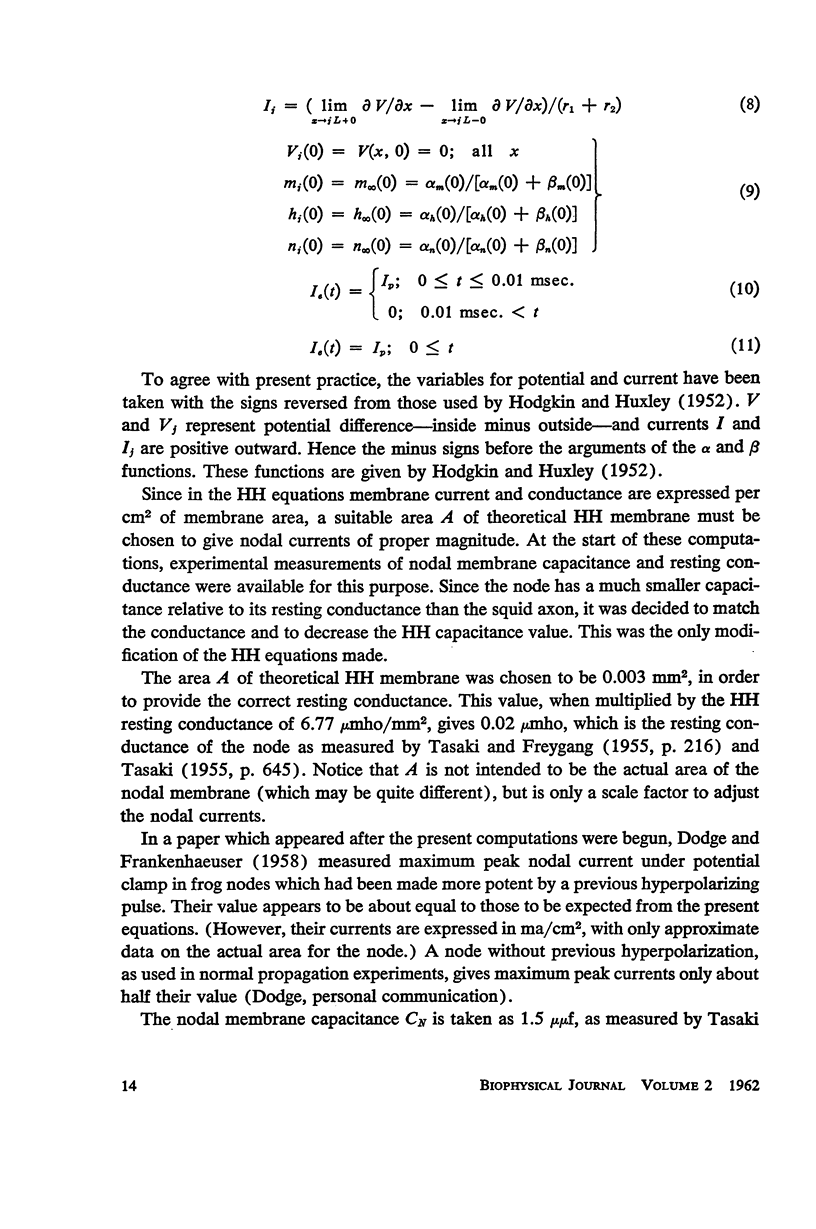Abstract
A mathematical model of the electrical properties of a myelinated nerve fiber is given, consisting of the Hodgkin-Huxley ordinary differential equations to represent the membrane at the nodes of Ranvier, and a partial differential cable equation to represent the internodes. Digital computer solutions of these equations show an impulse arising at a stimulating electrode and being propagated away, approaching a constant velocity. Action potential curves plotted against distance show discontinuities in slope, proportional to the nodal action currents, at the nodes. Action potential curves plotted against time, at the nodes and in the internodes, show a marked difference in steepness of the rising phase, but little difference in peak height. These results and computed action current curves agree fairly accurately with published experimental data from frog and toad fibers.
Full text
PDF










Selected References
These references are in PubMed. This may not be the complete list of references from this article.
- DODGE F. A., FRANKENHAEUSER B. Membrane currents in isolated frog nerve fibre under voltage clamp conditions. J Physiol. 1958 Aug 29;143(1):76–90. doi: 10.1113/jphysiol.1958.sp006045. [DOI] [PMC free article] [PubMed] [Google Scholar]
- FITZHUGH R. Thresholds and plateaus in the Hodgkin-Huxley nerve equations. J Gen Physiol. 1960 May;43:867–896. doi: 10.1085/jgp.43.5.867. [DOI] [PMC free article] [PubMed] [Google Scholar]
- GEORGE E. P. Action potentials in active tissue with delayed potassium permeability. Nature. 1960 Jun 11;186:889–890. doi: 10.1038/186889a0. [DOI] [PubMed] [Google Scholar]
- HODGKIN A. L., HUXLEY A. F. A quantitative description of membrane current and its application to conduction and excitation in nerve. J Physiol. 1952 Aug;117(4):500–544. doi: 10.1113/jphysiol.1952.sp004764. [DOI] [PMC free article] [PubMed] [Google Scholar]
- HODLER J., STAMPFLI R., TASAKI I. Role of potential wave spreading along myelinated nerve fiber in exictation and conduction. Am J Physiol. 1952 Aug;170(2):375–389. doi: 10.1152/ajplegacy.1952.170.2.375. [DOI] [PubMed] [Google Scholar]
- Huxley A. F., Stämpfli R. Evidence for saltatory conduction in peripheral myelinated nerve fibres. J Physiol. 1949 May 15;108(3):315–339. [PMC free article] [PubMed] [Google Scholar]
- LAPORTE Y. Continuous conduction of impulses in peripheral myelinated nerve fibers. J Gen Physiol. 1951 Nov;35(2):343–360. doi: 10.1085/jgp.35.2.343. [DOI] [PMC free article] [PubMed] [Google Scholar]
- TASAKI I., FRANK K. Measurement of the action potential of myelinated nerve fiber. Am J Physiol. 1955 Sep;182(3):572–578. doi: 10.1152/ajplegacy.1955.182.3.572. [DOI] [PubMed] [Google Scholar]
- TASAKI I., FREYGANG W. H., Jr The parallelism between the action potential, action current, and membrane resistance at a node of Ranvier. J Gen Physiol. 1955 Nov 20;39(2):211–223. doi: 10.1085/jgp.39.2.211. [DOI] [PMC free article] [PubMed] [Google Scholar]


